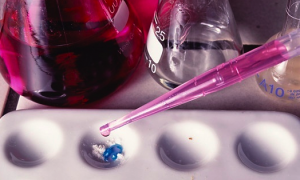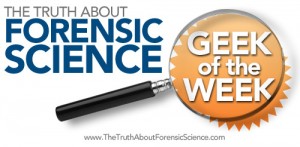The Forensic Science Geek of the Week
The week 43 “www.TheTruthAboutForensicScience.com Forensic Science Geek of the Week” honors goes to: Ron Moore, Esquire

- Ron Moore, Esquire-Forensic Science Geek of the Week
According to his website:
Ronald L. Moore received a Bachelors degree in Biology from UC Riverside and was a Senior Forensic Scientist at the Orange County Crime Lab, where he worked for over 18 years. During his time at the lab, Mr. Moore supervised the Forensic Alcohol Unit, as well as working in Toxicology, Blood and Breath Alcohol, Drug Analysis, Firearms and Toolmarks, and Crime Scene Investigation. He was Board Certified in Forensic Science by the American Board of Criminalistics. Mr. Moore is an experienced expert witness, with hundreds of appearances in DUI trials and DMV Administrative Hearings, as well as homicides and other major crime cases. Forensic Expert Ronald L. Moore is also a factory trained technician on the Intoximeters Alco-Sensor IV breath testing instrument used in Orange County. He is also certified in the performance of Standardized Field Sobriety Tests, and in the science behind these tests.
Mr. Moore attended Western State University College of Law, graduating Valedictorian,magna cum laude, with a Certificate in Criminal Law from the Criminal Law Practice Center, senior managing editor of the Law Review, and three term president of the Criminal Law Association. Criminal Defense Attorney Ronald L. Moore is licensed to practice in all California State Courts and is admitted to practice before the United States Supreme Court. Attorney Moore is a frequent speaker at local and national professional meetings on many aspects of alcohol testing, metabolism, and impairment, as well as driving under the influence of drugs. Ronald L. Moore represents clients in Orange County, California, primarily in cases of Driving under the Influence of Alcohol, Drugs or Prescription Medication, and testifies nationally as an expert in Driving under the Influence matters. Mr. Moore has written for the two volume treatise California Drink Driving Law, and is published in the Champion, the journal of the National Association of Criminal Defense Lawyers. He wrote a portion of the Appellants brief in the U.S. Supreme Court case of Treadway v. California, 129 S.Ct. 1039 (2009) and a portion of the Amicus Curiae brief in Bullcoming v. New Mexico (U.S. Supreme Court No. 09-10876).
Professional Memberships and Affiliations:
- State Bar of California
- United States Supreme Court Bar
- National College for DUI Defense
- National Association of Criminal Defense Lawyers
- California DUI Lawyers Association
- Orange County Bar Association
Congratulations to our Forensic Science Geek of the Week winner!
All hail the www.TheTruthAboutForensicScience.com Forensic Science Geek of the Week!!!
See the challenge question that our winner correctly answered.
OFFICIAL QUESTION:
-

- Forensic Science Geek of the Week Challenge
1. What is in the pipette and in the flask?
2. What is it used for?
3. What are the limitations to this assay?
Please visit the www.TheTruthAboutForensicScience.com FaceBook fan page.
Our Geek of the Week answered:
This is cobalt thoicyanate. It is a presumptive test for cocaine. It does cross react with other substances, and we would add hydrochloric acid to test cocaine base.
[BLOGGER’S NOTE: Here is some more information:
Source and photo credit: http://www.sciencephoto.com/images/download_lo_res.html?id=722000162
“The pipette is adding cobalt thiocyanate solution (pink) to a sample of cocaine (white) to produce the blue precipitate that is the [presumptive] positive result of this test for cocaine… The conical flask at upper left contains cobalt thiocyanate solution, which needs to be acidified to ensure detection of some forms of cocaine.”
This is also referred to as the “Scott Test.” There are a lot of substances that can cause false positive when this reagent is used. This includes, but is not limited to: (1) antihistamines that include Diphenhydramine as a component such as Nytol, Unisom (though some Unisom products contain doxylamine instead), Tylenol PM, Midol PM and Advil PM and (2) any compound that has lidocaine in it. There are other substances that will also respond as a false positive. Therefore, at most, it is a screening assay.
There are two great Honorable Mentions (Remember the winner is the first correct and complete answer. So, that means our Honorable Mention folks were just a little behind our Forensic Science Geek of the Week Winner.):
David M. Benjamin, Ph.D., Clinical Pharmacologist and Forensic Toxicologist, wrote: “This is a cobalt thiocyanate screening test for cocaine. Cobalt thicyanate is pink, and the crystals in the reaction vessel are cocaine powder. It’s use is for the presumptive or preliminary qualitative analysis of cocaine HCl and, maybe cocaine base, which may require the addition of HCl to convert the cocaine base to HCl (hydrochloride) to obtain the “blue color” indicating the possible presence of cocaine. It’s limitations are that it is a screening test and requires confirmation by either IR spectroscopy or GC/MS, and that both diphenhydramine (Benadryl), an antihistamine, and lidocaine, (Xylocaine), a local anesthetic, give “false positive” blue colors which can be misinterpreted as an indication of the presence of cocaine.”
Mehul B. Anjaria wrote “Looks like the cobalt thiocyanate test for cocaine. This is a simple color test that is presumptive in nature. It therefore, is in no way is a chemical confirmation that the substance contains cocaine. The reagent is added to suspected cocaine. Cocaine hydrochloride will then turn bright blue (with crack or cocaine base producing only a dull blue). The subsequent addition of hydrochloric acid will change the color back to pink. Good test for the field and to guide the rest of the analytical process toward a suspected family of drugs; however, it is solely a presumptive test as false positives will occur.”
The Hall of Fame for the www.TheTruthAboutForensicScience.com Forensic Science Geek of the Week:
Week 1: Chuck Ramsay, Esquire
Week 2: Rick McIndoe, PhD
Week 3: Christine Funk, Esquire
Week 4: Stephen Daniels
Week 5: Stephen Daniels
Week 6: Richard Middlebrook, Esquire
Week 7: Christine Funk, Esquire
Week 8: Ron Moore, B.S., J.D.
Week 9: Ron Moore, B.S., J.D.
Week 10: Kelly Case, Esquire and Michael Dye, Esquire
Week 11: Brian Manchester, Esquire
Week 12: Ron Moore, B.S., J.D.
Week 13: Ron Moore, B.S., J.D.
Week 14: Josh Lee, Esquire
Week 15: Joshua Dale, Esquire and Steven W. Hernandez, Esquire
Week 16: Christine Funk, Esquire
Week 17: Joshua Dale, Esquire
Week 18: Glen Neeley, Esquire
Week 19: Amanda Bynum, Esquire
Week 20: Josh Lee, Esquire
Week 21: Glen Neeley, Esquire
Week 22: Stephen Daniels
Week 23: Ron Moore, B.S., J.D.
Week 24: Bobby Spinks
Week 25: Jon Woolsey, Esquire
Week 26: Mehul B. Anjaria
Week 27: Richard Middlebrook, Esquire
Week 28: Ron Moore, Esquire
Week 29: Ron Moore, Esquire
Week 30: C. Jeffrey Sifers, Esquire
Week 31: Ron Moore, Esquire
Week 32: Mehul B. Anjaria
Week 33: Andy Johnston
Week 34: Ralph R. Ristenbatt, III
Week 35: Brian Manchester, Esquire
Week 36: Ron Moore, Esquire
WEEK 37: UNCLAIMED, IT COULD BE YOU!
Week 38: Pam King, Esquire
Week 39: Josh Lee, Esquire
WEEK 40: UNCLAIMED, IT COULD BE YOU!
WEEK 41: UNCLAIMED, IT COULD BE YOU!
WEEK 42: Steven W. Hernandez, Esquire
WEEK 43: Ron Moore, Esquire



